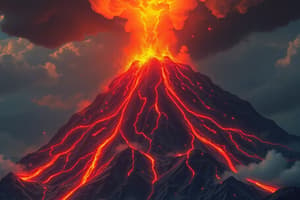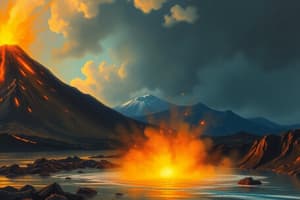Podcast
Questions and Answers
Geothermal energy is harnessed from the Earth's natural ______
Geothermal energy is harnessed from the Earth's natural ______
heat
Stratovolcanoes are composed of alternating layers of ______ and ash
Stratovolcanoes are composed of alternating layers of ______ and ash
lava
Shield volcanoes have broad, low-profile shapes with gently sloping ______
Shield volcanoes have broad, low-profile shapes with gently sloping ______
sides
Cinder cones are small, steep-sided volcanoes with a crater at the ______
Cinder cones are small, steep-sided volcanoes with a crater at the ______
The 1991 eruption of Mount Pinatubo cooled the Earth by ______ for several years
The 1991 eruption of Mount Pinatubo cooled the Earth by ______ for several years
Eruptions can disrupt lives, economies, and ______
Eruptions can disrupt lives, economies, and ______
When magma, gas, and debris burst through the Earth's surface, we witness a _______ eruption_, which can have a profound impact on our environment, climate, and society.
When magma, gas, and debris burst through the Earth's surface, we witness a _______ eruption_, which can have a profound impact on our environment, climate, and society.
The _______ Explosivity Index (VEI)_ helps classify eruptions based on their magnitude.
The _______ Explosivity Index (VEI)_ helps classify eruptions based on their magnitude.
Hawaiian (______): Slow-moving lava flows cover large areas, often forming new land like Hawaii's Big Island.
Hawaiian (______): Slow-moving lava flows cover large areas, often forming new land like Hawaii's Big Island.
Alaskan (______): Steam and ash are blasted high into the atmosphere, typically forming a caldera.
Alaskan (______): Steam and ash are blasted high into the atmosphere, typically forming a caldera.
Pelean (______): Gas and steam produce pyroclastic flows and surges, creating temples of ash and debris.
Pelean (______): Gas and steam produce pyroclastic flows and surges, creating temples of ash and debris.
Plinian (______): Powerful eruptions release enormous quantities of ash into the atmosphere, sometimes leading to global climate changes.
Plinian (______): Powerful eruptions release enormous quantities of ash into the atmosphere, sometimes leading to global climate changes.
Flashcards are hidden until you start studying
Study Notes
Volcanoes and Volcanic Eruptions
Volcanoes are nature's reservoirs of molten rock and gases, a result of the Earth's tectonic activity. When magma, gas, and debris burst through the Earth's surface, we witness a volcanic eruption, which can have a profound impact on our environment, climate, and society.
Types of Volcanic Eruptions
Volcanic eruptions can vary in intensity, style, and consequences. The Volcanic Explosivity Index (VEI) helps classify eruptions based on their magnitude. There are five main types of eruptions:
- Hawaiian (effusive): Slow-moving lava flows cover large areas, often forming new land like Hawaii's Big Island.
- Alaskan (explosive): Steam and ash are blasted high into the atmosphere, typically forming a caldera. Examples include the 1912 eruption of Novarupta and the 1980 eruption of Mount Saint Helens.
- Strombolian (vulcanian): Lava blasts out of the volcano in a fountain-like manner, creating short-lived columns of ash.
- Pelean (steam-driven): Gas and steam produce pyroclastic flows and surges, creating temples of ash and debris.
- Plinian (supervolcanic): Powerful eruptions release enormous quantities of ash into the atmosphere, sometimes leading to global climate changes. Mount Santorini and Santorini Caldera are examples of Plinian eruptions.
Impacts of Volcanic Eruptions
Volcanic eruptions have far-reaching consequences:
- Environmental: Eruptions can release large amounts of ash, sulfur dioxide, and carbon dioxide into the atmosphere, affecting local and global climates. The 1991 eruption of Mount Pinatubo cooled the Earth by 0.5°C for several years.
- Geological: Eruptions can create new land, reshape landscapes, and form calderas.
- Societal: Eruptions can disrupt lives, economies, and travel, as seen during the 1980 eruption of Mount Saint Helens.
Geothermal Energy
Geothermal energy, harnessed from the Earth's natural heat, is another benefit of volcanic activity. Geothermal power plants collect steam and hot water from the ground to generate electricity. Iceland, New Zealand, and the Philippines are some of the world's leading producers of geothermal energy, harnessing the heat from their active volcanoes.
Types of Volcanoes
Volcanoes can be categorized into three main types based on their tectonic setting and overall structure:
- Stratovolcanoes (composite volcanoes): Composed of alternating layers of lava and ash, these conical volcanoes are often found at the boundaries of tectonic plates. Examples include Mount Fuji in Japan and Mount Rainier in the United States.
- Shield volcanoes: Broad, low-profile volcanoes with gently sloping sides, formed from the accumulation of fluid lava flows. Examples include Mauna Loa in Hawaii and Tangaroa in New Zealand.
- Cinder cones: Small, steep-sided volcanoes with a crater at the top, formed from lava fragments and ash. Examples include Lassen Peak in California and Paricutín in Mexico.
Understanding volcanoes and their various types, eruption styles, and impacts is crucial for predicting and mitigating the risks they pose to our planet and society. From the production of geothermal energy to the study of Earth's geological processes, volcanoes are a powerful force to be reckoned with.
Studying That Suits You
Use AI to generate personalized quizzes and flashcards to suit your learning preferences.




